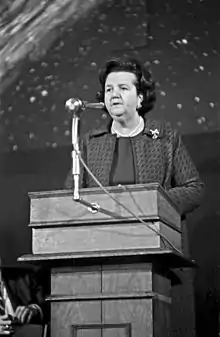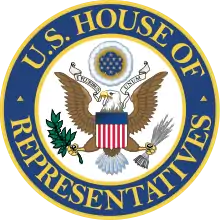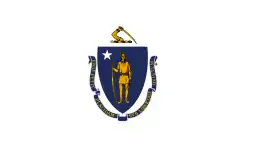Louise Day Hicks
Anna Louise Day Hicks (October 16, 1916 – October 21, 2003) was an American politician and lawyer from Boston, Massachusetts, best known for her staunch opposition to desegregation in Boston public schools, and especially to court-ordered busing, in the 1960s and 1970s. A longtime member of Boston's school board and city council, she served one term in the United States House of Representatives, succeeding John William McCormack.
Louise Day Hicks | |
|---|---|
 | |
| Member of the Boston City Council | |
| In office 1979–1981 | |
| Preceded by | James Michael Connolly |
| Succeeded by | John W. Sears |
| In office 1974–1978 | |
| In office 1970–1971 | |
| Succeeded by | Dapper O'Neil |
| President of the Boston City Council | |
| In office 1976–1976 | |
| Preceded by | Gerald O'Leary |
| Succeeded by | Joseph M. Tierney |
| Member of the U.S. House of Representatives from Massachusetts's 9th district | |
| In office January 3, 1971 – January 3, 1973 | |
| Preceded by | John William McCormack |
| Succeeded by | Joe Moakley |
| Chair of the Boston School Committee | |
| In office 1963–1965 | |
| Preceded by | Joseph Lee |
| Succeeded by | Thomas S. Eisenstadt |
| Member of the Boston School Committee | |
| In office 1961–1970 | |
| Personal details | |
| Born | Anna Louise Day October 16, 1916 Boston, Massachusetts, US |
| Died | October 21, 2003 (aged 87) Boston, Massachusetts, US |
| Resting place | Saint Joseph Cemetery, West Roxbury, Massachusetts |
| Political party | Democratic |
| Spouse(s) | John Hicks |
The daughter of a wealthy and prominent attorney and judge, Hicks attended Simmons College and received her qualification as a teacher from Wheelock College. She worked as a first grade teacher in Brookline, Massachusetts prior to marrying in 1942. After the births of her two children, Hicks returned to school and completed a Bachelor of Science degree at Boston University in 1952. In 1955, she received a JD from Boston University Law School, attained admission to the bar, and entered into partnership with her brother as the firm of Hicks and Day.
In 1960, Hicks won election to Boston's school board, where she served until 1970, including holding the position of chairwoman from 1963 to 1965. During her tenure on the school committee, she came into conflict with civil rights groups and black residents of Boston over her opposition to plans to integrate schools by busing students between districts to achieve racial balance. From 1970 to 1971, she served on the Boston City Council. In 1970, she won the Democratic nomination for the U.S. House seat of the retiring John McCormack. She went on to win the general election and serve one term, 1971 to 1973. In 1971, she was an unsuccessful candidate for mayor of Boston. She was defeated for reelection to Congress in 1972 by Joe Moakley, a Democrat who ran as an independent.
After leaving Congress, Hicks was the head of an anti-busing group, "Restore Our Alienated Rights" (ROAR), which remained active until a 1976 federal court decision mandated busing to achieve integration in public schools. In 1974, Hicks returned to the Boston City Council, and she served until 1978, including holding the council president's position in 1976. She lost reelection in 1977, but was appointed to fill a vacancy in 1979. She served until 1981, and was an unsuccessful candidate for reelection. Hicks died in Boston in 2003, and was buried at Saint Joseph Cemetery in West Roxbury.
Early life
Hicks was the daughter of William J. Day and Anna (née McCarron) Day. Hicks described her father, a lawyer and an influential judge in Boston, as her "greatest influence".[1] The child of poor Irish immigrants, William Day became one of the wealthiest men in South Boston as a result of his law practice, real estate investments and his role as director of South Boston's Mount Washington Cooperative Bank. Day was admired by Boston's Irish community: as a banker he provided assistance to families struggling to make mortgage payments and as a judge he was particularly lenient towards juvenile defendants. In her own political career, Hicks would benefit from her father's reputation.[2]
Hicks' mother died when Hicks was only fourteen years of age. In 1942, she married John Hicks, an engineer, and they had two sons, John and William.[3] John Edward Hicks (b. 1945) had several brushes with the law, including a prison sentence for kidnapping.[4] He disappeared in 1978, while he was facing more than 20 charges related to a 1977 incident in which he threatened harm to several customers inside a restaurant and then attempted to run over several of them in the parking lot.[4] John Hicks was still missing at the time of his mother's death.[5]
Hicks studied home economics at Simmons College and then later earned a teaching certificate at Wheelock College. She worked as a first grade teacher in Brookline, Massachusetts, for two years and pursued a degree in education at Boston University.[6]
Hicks earned a Bachelor of Science degree from Boston University in 1952, and a JD from Boston University Law School in 1955. Hicks stated that her father's death in 1950 left her resolved to follow in his footsteps. At this time female law students were still rare; Hicks was one of only nine women in her class of 232. Hicks formed close friendships with two other female students, one Jewish and one black, and she studied for exams with a group made up of mostly minorities. Hicks was admitted to the bar and practiced law with her brother John as the firm of Hicks and Day.[7]
De facto segregation
Hicks ran successfully for the Boston School Committee in 1961, presenting herself as a reform candidate. Although her own children attended parochial schools (private Catholic schools), her campaign slogan was "The only mother on the ballot". [8] In January 1963, she became the committee chairperson and seemed likely to be endorsed by the leading reform group when, in June, the Boston chapter of the NAACP demanded "an immediate public acknowledgment of de facto segregation in the Boston public school system." At the time, 13 city schools were at least 90% black.
The committee refused to acknowledge the segregation. Hicks was recognized as the holdout; within months she became Boston's most popular politician and the most controversial, requiring police bodyguards 24 hours a day. Hicks became nationally known in 1965 when she opposed court-ordered busing of students into inner-city schools to achieve integration.
By refusing to admit that segregation existed in city schools and by declaring that children were the "pawns" of racial politics, she came to personify the discord that existed between some working class[9] Irish-Americans and African-Americans. "Boston schools are a scapegoat for those who have failed to solve the housing, economic, and social problems of the black citizen", Hicks said. She asserted that while thirteen Boston schools were at least 90% black, Chinatown schools were 100% Chinese, the North End had schools that were 100% Italian American, and South Boston contained schools that were mostly Irish American. The Boston public schools included a conglomerate of white ethnics with very few WASPs.
Mayoral bid, city council, and Congress

In 1967, Hicks came within 12,000 votes of being elected mayor of Boston, running on the slogan, "You know where I stand." The nonpartisan race against fellow Democrat Kevin White became so acrimonious that the Boston Globe broke a 75-year tradition of political neutrality to endorse White.[10] After the unsuccessful mayoral bid, Hicks ran for city council and won. Two years later, after Speaker John W. McCormack retired after 43 years in Congress, Hicks beat out eleven other candidates to win the Democratic primary for his South Boston congressional district. In heavily Democratic Boston, the winner of that primary was essentially assured victory in the November election.
Hicks served one term in the United States House of Representatives from 1971 to 1973, becoming the first female Democrat to represent Massachusetts in the House. Despite her identification with the white backlash, Hicks took many progressive stands in Congress. She was a member of the National Organization for Women and lobbied for passage of the Equal Rights Amendment while in Congress.[1] She also won relatively high ratings from the League of Conservation Voters.[11]
While in Congress Hicks ran again for Mayor of Boston in 1971. She made the runoff, but was again defeated by Kevin White, this time by a much wider margin.[12] She sought reelection to Congress in 1972, but was narrowly defeated in the general election by City Councilman Joe Moakley, a more liberal Democrat who was running as an Independent. Moakley reverted to his Democratic party affiliation after he entered the House.
There were 223 murders in Boston from 1973 to 1974, but only two dozen involved blacks killing whites. Hicks claimed, however, that there were "at least one hundred black people walking around in the black community who have killed white people during the last two years."[13] Hicks took aim at "radical agitators" and "pseudo-liberals" of the counterculture. She declared that "white women can no longer walk the streets [of Boston] in safety" and that "justice [had come] to mean special privileges for the black man and the criminal." She attacked "black militants [who] tyrannize our schools, creating chaos and disruption."[14]
In her relatively brief political career, Hicks was excoriated by liberal politicians and activists. The columnist Joseph Alsop called her "Joe McCarthy dressed up as Polyanna"; civil rights leaders likened her to Adolf Hitler or Bull Connor of Birmingham, Alabama. Newsweek published a satirical article ridiculing the Irish culture of South Boston, a matter which prompted Hicks to reply with a full-page newspaper ad.[15]
In 1973, Hicks ran for the Boston City Council again and won. Her most notable campaign took place in autumn 1975, after a federal judge ordered Boston schools to expand their busing programs to comply with the 1971 Swann v. Charlotte-Mecklenburg Board of Education decision. To counter the trend, Hicks started an organization called Restore Our Alienated Rights (ROAR) which actively engaged in incidents of massive resistance to school desegregation. In 1976, Hicks was elected the first woman president of the Boston City Council, largely on the strength of ROAR, which was then at its peak. During this time Hicks supported another controversial position, a curfew for minors in the city of Boston.[16][17]
Hicks opposed George Wallace of Alabama, who ran for U.S. President on four occasions: "He's a segregationist. I don't want to be connected to him."[18] Hicks continued, "While a large part of my vote probably does come from bigoted people. ... I know I'm not bigoted. To me the word means all the dreadful southern segregationist, Jim Crow business that's always shocked and revolted me."[19]
Retirement
She was defeated for reelection to the Boston City Council in 1977, finishing tenth in the race for nine positions. In 1979, Councilor James Michael Connolly was elected Register of Probate for Suffolk County and resigned from the council, and as 10th-place finisher in the 1979 election, Hicks filled the vacant seat only to lose again in 1981. Hicks began to experience health problems and retired from politics after that.
Death and burial
Hicks died in Boston on October 21, 2003. She was buried at Saint Joseph Cemetery in West Roxbury, Massachusetts.[20]
Notes
- Feeney 2003.
- Lukas 1986, pp. 116–118.
- Reed, Christopher (28 October 2003). "Obituary: Louise Day Hicks". The Guardian. Retrieved 20 June 2013.
- Connolly, Richard J. (February 8, 1979). "Hicks' Disappearance Worries Kin". The Boston Globe. Boston, MA. p. 40 – via Newspapers.com.
- Zezima, Katie (October 23, 2003). "Louise Day Hicks Dies at 87". The New York Times. New York, NY – via subscription.
- Lukas 1986, pp. 118–119.
- Lukas 1986, pp. 118–120.
- Lukas 1986, p. 123.
- Meagher, Timothy J. (August 13, 2013). The Columbia Guide to Irish American History. Columbia University Press. p. 156. ISBN 9780231510707.
- John A. Farrell, Tip O'Neill and the Democratic Century (Boston: Little Brown & Company, 2001), p. 522
- http://scorecard.lcv.org/sites/scorecard.lcv.org/files/LCV_Scorecard_1972_House.pdf
- https://archive.org/stream/annualreportofbo1971bost#page/44/mode/2up
- Dominic Sandbroook, Mad as Hell: The Crisis of the 1970s and the Rise of the Populist Right (New York City: Alfred A. Knopf, 2011, p. 53); ISBN 9781400042623
- Sandbrook, Mad As Hell, p. 109
- Sandbrook, Mad As Hell, pp. 109-110
- "Archived copy". Archived from the original on 2011-08-17. Retrieved 2011-07-06.CS1 maint: archived copy as title (link)
- Sandbrook, Mad As Hell, pp. 110–111
- Sandbrook, Mad as Hell, p. 115
- Sandbrook, Mad As Hell, p. 115
- Biographical Directory of the United States Congress
References
- Feeney, Mark (22 October 2003). "Louise Day Hicks, icon of tumult, dies". The Boston Globe. Retrieved 21 June 2013.
- Lukas, J. Anthony (1986). Common Ground: A Turbulent Decade in the Lives of Three American Families (1st Vintage Books ed.). New York: Vintage Books. ISBN 0394746163.
External links
- United States Congress. "Louise Day Hicks (id: H000566)". Biographical Directory of the United States Congress.
- Boston Globe obituary
- Guardian obituary
- WGBH Open Vault
- Guide to the Louise Day Hicks records at the Boston City Archives
| Political offices | ||
|---|---|---|
| Preceded by John W. McCormack |
Member of the U.S. House of Representatives from Massachusetts's 9th congressional district 1971–1973 |
Succeeded by Joe Moakley |
| Preceded by Gerald O'Leary |
President of the Boston City Council 1976 |
Succeeded by Joseph M. Tierney |

